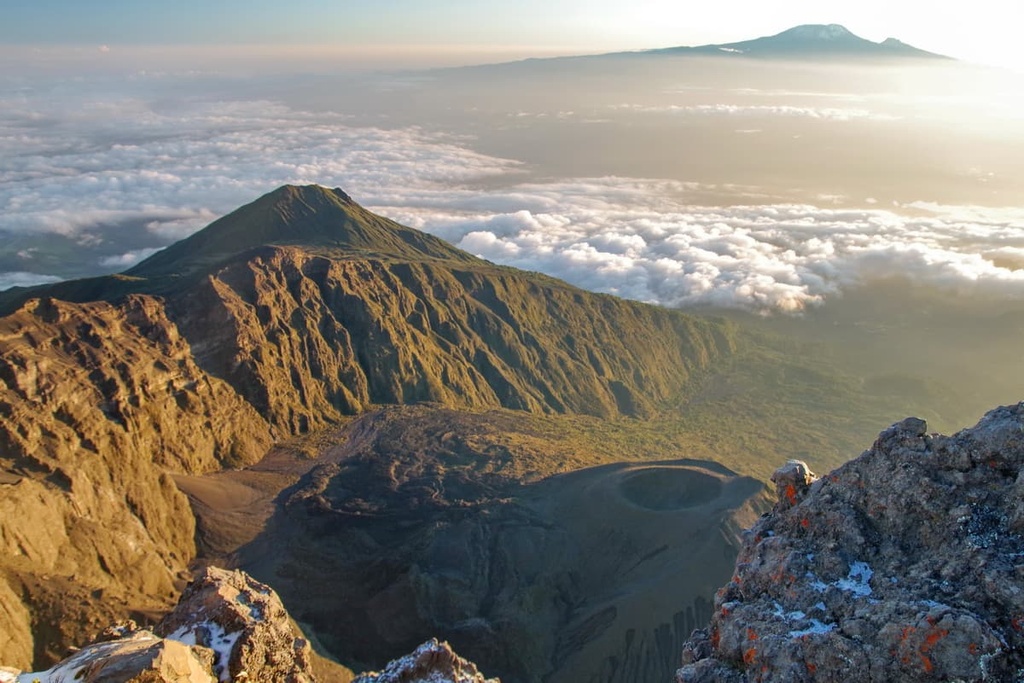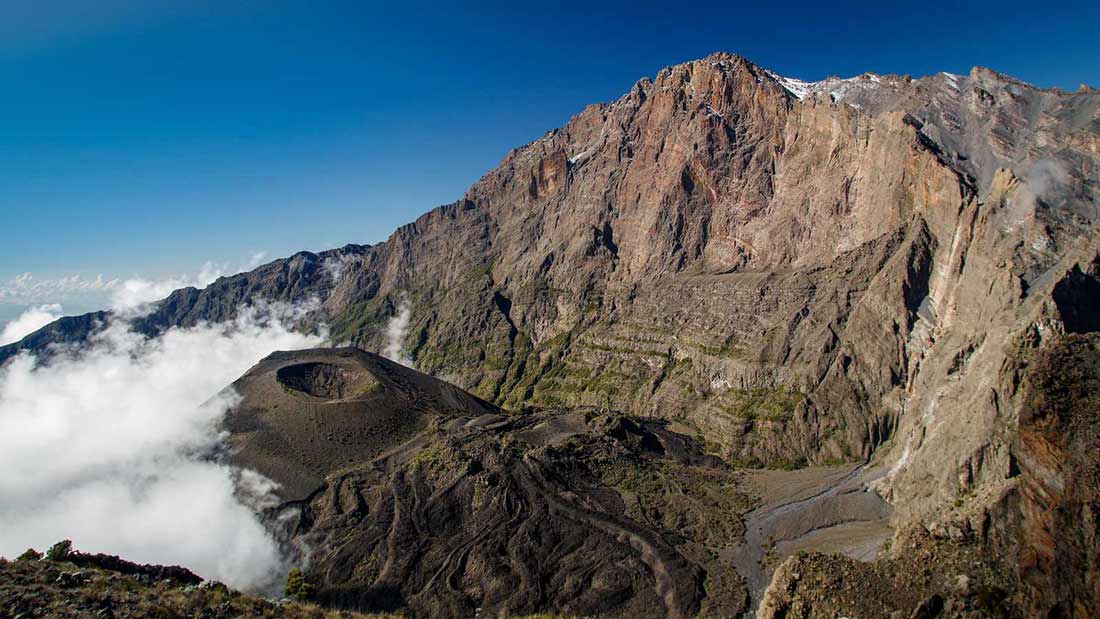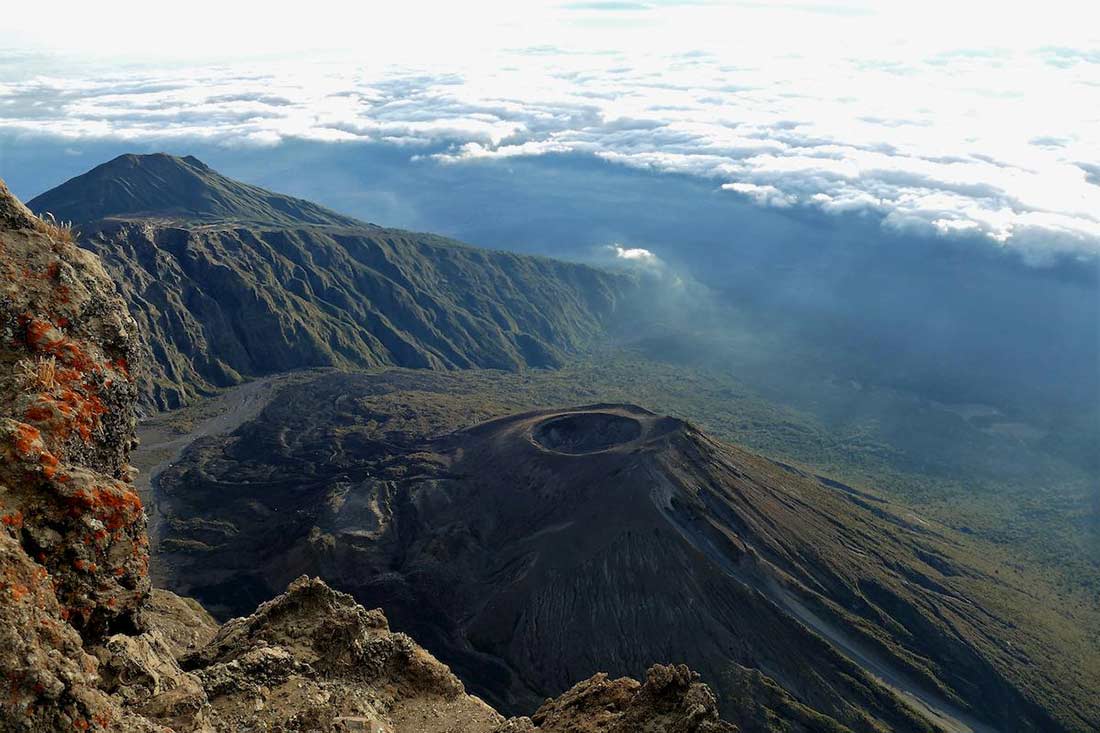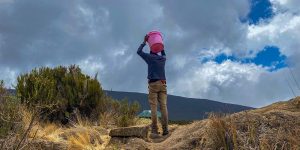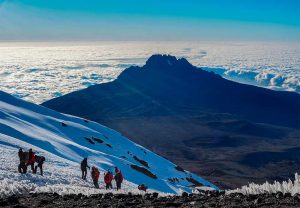Mount Meru is the fifth tallest mountain in Africa. It is also the second-highest mountain in Tanzania. It’s near Mount Kilimanjaro and you can climb it. But is Mount Meru worth climbing?
Many people chose to climb Meru before they climb Mount Kilimanjaro. They do this for a couple of reasons.
One is that the mountain exists. Many people like the challenge of climbing mountain peaks. They are referred to as “Peakbaggers”. They like to “bag” a new peak on each adventure.
The second reason people like to climb Meru is to acclimate to the elevation before heading up Kilimanjaro. Meru stands at 14,968 feet. This is taller than any mountain in the lower 48 states. Mount Whitney, by comparison, is 14,505 feet or 463 feet lower than Meru.
If you are planning on climbing Kilimanjaro and don’t have access to a tall mountain near where you live. You can book a Meru climb a few days before climbing Kilimanjaro.
When you do climb, you will have a park ranger with you. Additionally, many budget operators will book your Meru climb and not send anyone with you. We have had lost or confused hikers ask our guides questions and try to hang with our clients. This is a frowned-upon practice and is the reason we encourage you to book with a reputable operator.
Meru Facts
- Meru is a dormant stratovolcano
- It should not be confused with Meru Peak in India.
- It’s 43 miles west of Kilimanjaro in the southeast Arusha Region of Tanzania.
- Height: 14,968 ft (4,562.13 meters)
- Visible from Kilimanjaro on a clear day
- Meru is north of the city of Arusha, where our Kilimanjaro climbs and safaris begin
- The Momella route is the route to the summit. You begin the trek at the Momella gate, on the eastern side of the mountain
- Much of its size disappeared about 7,800 years ago due to a summit collapse.
- Meru most recently had a minor eruption in 1910.
- The several small cones and craters seen in the vicinity are evidence of frequent volcanic activity.
- Meru’s caldera is 2.2 miles (3.5 kilometers) wide. A caldera is a large depression formed when a volcano erupts and collapses.
- Meru is the topographic centerpiece of Arusha National Park. Its fertile slopes rise above the surrounding savanna and support a forest that hosts diverse wildlife, including 400 species of birds, as well as monkeys, and leopards.
- The movie Hatari! was filmed at the foot of Meru.

Just like Kilimanjaro, you have to ascend through several different zones of vegetation to reach its summit. However, unlike Kilimanjaro, Meru has a lot more wildlife to observe as you ascend to its crater rim. Meru lies in the heart of Arusha National Safari Park. So along the trek, you may see monkeys, giraffes, elephants, dik dik, warthog, and water buffalo. If birds are your thing, then keep your eyes out for the Hartlaub turaco or the silver-cheeked hornbill.
Meru Climb
Meru: Day 1
4-6 hours · 6.2 miles · elevation: +3,330 ft.
Your adventure begins by checking into Arusha National Park before proceeding through the Momella Gate (4,921 ft.). The trek starts in the grasslands where you’ll view water buffalo, warthogs, and elephants. Shortly, you’ll begin a steady ascent through the montane forest. You’ll stop at the famous fig tree to enjoy your lunch. By mid-afternoon, you have closer views of Meru’s towering cliffs and Ash Cone. The Miriakamba Huts (8,250 ft.) are situated in an idyllic grassy glade, and you will reach them in time to enjoy the beautiful views over the surrounding plains. If you are lucky, a giraffe may walk through the camp.
Meru: Day 2
3-5 hours · 4.9 miles · elevation: +3,460 ft.
It is often clear in the morning, which may make it possible to view Kilimanjaro. From the Miriakamba Huts, you’ll climb steeply to the crater rim, called Elephant Ridge. You’ll follow a steep path through lush montane forest to reach the giant heather in the Moorland region near the saddle between Little Meru and the summit. A hot lunch will welcome you to Saddle Huts (11,712 ft.). Your afternoon is free to rest and enjoy the views or make the short climb to the nearby summit of Little Meru (12,533 ft.).
Meru: Day 3
10-12 hours · 11.1 miles · elevation: +3,285 ft., -6,747 ft.
The summit push starts around 2 AM, It begins by climbing steeply for an hour to Rhino point (12,467 ft.). In icy conditions or strong winds, it may be unsafe to continue past Rhino Point, but sunrise from here is equally as spectacular as from Cobra Point. If the weather is fine, you’ll descend slightly and continue along or near a rough undulating ridge of ash and rock to reach Cobra Point (14,271 ft.). The stunning views include the cliffs of the crater rim, the Ash Cone rising from the crater floor, Kilimanjaro floating on the morning clouds, and the Rift Valley. As the sun climbs higher, the hike continues for another hour on a steep path to reach the summit of Meru (14,997 ft.). The view from the top is breathtaking.
Your hike back to Rhino Point between the crater’s sloping outer wall and the sheer cliffs of the inner wall is one of the most dramatic and exhilarating walks in Africa. Enjoy brunch and a well-earned rest at the Saddle Huts before continuing your descent to Miriakamba Huts where you will spend the night.
Meru: Day 4
2-4 hours · 6.2 miles · elevation: -3,330 ft.
You’ll descend rapidly on a slightly different route than you ascended. You’ll pass through open grassland and mixed forest, with good chances of seeing wildlife. This trail has excellent views back towards the crater and over the plains of the national park. You will reach Momella Gate by late morning. A vehicle will take you back to Arusha where it is time for celebration.
Final Thoughts
Whether you are new to trekking or an avid hiker, Mount Meru is worth climbing. Many people consider it more difficult than some of the routes on Kilimanjaro. If you choose to add it to your itinerary, you won’t be disappointed.

